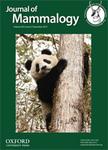版权所有:内蒙古大学图书馆 技术提供:维普资讯• 智图
内蒙古自治区呼和浩特市赛罕区大学西街235号 邮编: 010021

作者机构:Ilia State Univ Inst Ecol Ctr Biodivers Studies Cholokashvili Str 5 GE-0162 Tbilisi Georgia RASci Daghestan Sci Ctr Precaspian Inst Biol Resources Moscow Russia Ilia State Univ Inst Ecol Program Ecol & Conservat Large Mammals Cholokashvili Str 5 GE-0162 Tbilisi Georgia
出 版 物:《JOURNAL OF MAMMALOGY》 (哺乳动物学杂志)
年 卷 期:2018年第99卷第4期
页 面:885-897页
核心收录:
学科分类:0710[理学-生物学] 07[理学] 071002[理学-动物学]
基 金:Ministry of Environment and Natural Resources Protection of Georgia
主 题:abundance biome Capra spp. distribution generalized additive models glacial refugium LGM
摘 要:Our research attempts 1) to link the distribution and abundance of eastern tur (Capra cylindricornis) to environmental variables varying in space and time, and 2) to identify environmental constraints that may have caused the geographic segregation of eastern tur from western tur (Capra caucasica). Our results suggest that 1) eastern tur are heat-sensitive but prefer snow-free, grass-dominated areas near escape cliffs, and in terrain that is difficult for humans and livestock to reach;and 2) present-day genetic and phenotypic differences between the Capra species are largely related to discontinuity of and impeded migration between Capra populations during glacial periods, and insufficient time in the postglacial period for now-adjoining Capra populations to overcome behavioral mechanisms impeding hybridization in the wild so as to erase these differences.